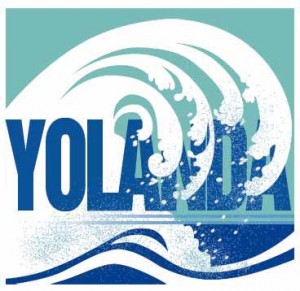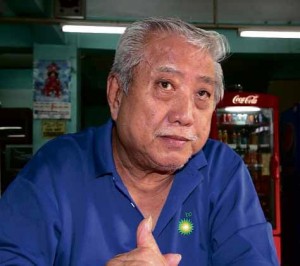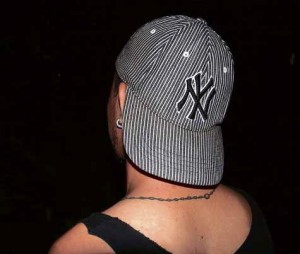Tale of 2 Taclobanons
(Last of a series)

A 29-year-old gay man, Stephanie joined a mob of looters that ransacked an automated teller machine (ATM) inside Robinson’s Mall along Tabo-an Road, a day after Super Typhoon “Yolanda” (international name: Haiyan) ravaged this city.
The constantly unemployed makeup artist made off with more than P300,000 in cold, hard cash as other looters stole cell phones, laptops and flatscreen TVs.
At about the same time, local businessman Jack Uy was pleading with looters to spare his family at his Astra Mart grocery along Burgos Street.
“Kinabuhi o karikuhan (Your life or your wealth),” the looters—armed with knives, crowbars and hacksaws—threatened Uy in Waray, leaving him with no choice but to give in to the mob.
“Money, that’s nothing. I had to protect my family,” said Uy, 68, president of the Tacloban Filipino-Chinese Chamber of Commerce. He claims his businesses lost millions.
“They were not typhoon victims. They were just plain criminals,” Uy said. “They took everything they could get their hands on,” said Uy, whose
father—a penniless immigrant from Fookien, China—arrived in this city several years ago to start a new life.
‘Gone in seconds’
Uy inherited his father’s business that grew to include groceries, drug stores, rice mills, an ice plant and a hotel: Most of them were looted. “All your years of hard work, gone in seconds,” Uy said, fighting back tears.

THE LOOTED Jack Uy, a Tacloban trader who lost millions of pesos in the looting after “Yolanda,” has returned to help rebuild the city. DANNY PETILLA / CONTRIBUTOR
The looting—in the wake of the strongest storm to ever hit land—bled this city dry as hungry and desperate storm survivors joined mobs raiding business establishments, carting away more than a billion pesos in cash and goods in what local residents described as the “looting of the century.”
More than the storm, the looting in the immediate aftermath transfixed the world and stirred a maelstrom of debate over what is acceptable human behavior in times of a major disaster like Yolanda.
“There was total absence of law and order on those days. Even policemen stayed away and some joined the looting,” said a local judge, who spoke on condition that he not be named.
“The reaction of the people was perfectly normal because of their basic need for survival,” said Arabelle B. Tenebro, a psychology professor at Eastern Visayas State University.
Theft is theft
But Tenebro admitted that most looters took advantage of the chaos by joining in the pillaging themselves. “That is not normal anymore,” said Tenebro, who witnessed looting at Gaisano Mall along Justice Romualdez Street.
“Hunger is not enough justification for looting and thievery. Theft is still theft,” said lawyer Tyrone Tutaan.

THE LOOTER “Stephanie,” the Tacloban looter who took P385,000 from an ATMmachine, has vowed to reform himself and seek redemption. DANNY PETILLA / CONTRIBUTOR
Only a few people were charged for qualified theft in the massive looting, including Orlando Dajoya, 51, a barangay councilor. Arrested by police inside the Sam’s Trading warehouse on Lopez Jaena Street, his trial on theft charges will start on Feb. 26 next year.
“There were bigger fish to fry. Why pick on him,” said the judge.
The judge was referring to two members of Tacloban’s high society: an obstetrician from Divine Word University Hospital and a flamboyant lawyer and former city councilman who were caught by CCTV cameras looting inside Robinson’s Mall: the doctor helped herself with jewelry while the lawyer carted off a big-screen TV.
Both fled with the doctor reportedly ending up as a caregiver at a nursing home in the United States and the lawyer constantly watching his back like a fugitive, according to relatives.
“What is sad is that these people are hardly hungry. They are in fact rich,” Tenebro said.
A local representative of Robinson’s Mall said the owners had decided not to charge any looter to “help the city heal and recover.”
But some officials claim this is not the real reason. “Charging the looters would not look good on these businessmen, especially if they demand insurance reparation for their losses,” said a National Bureau of Investigation official.
Great equalizer
“Yolanda was the greatest equalizer. Rich and poor fled Tacloban in droves,” said Uy, who left the city with his family five days after the storm.
As rumors traveled fast that he was going to be arrested, Stephanie fled Tacloban on Nov. 20.
Both men—looter and looted-ended up in Cebu with opposite objectives: Stephanie was ready to enjoy his loot while Uy took stock of his losses.
“I thought I was the king of the world,” Stephanie said. Generous to a fault, he became Cebuana Lhuiller’s frequent customer as he wired cash to friends and relatives in Manila and Leyte.
“I sent money to my mother. I sent money to everyone who asked money from me. Last December, I was Santa Claus,” Stephanie said.
Succumbing to the call of the flesh, Stephanie hired male prostitutes, mixed “shabu” (methamphetamine hydrochloride) and alcohol as his drunken orgies filled his senses to the brim.
Inspiration
As two lovers fought for his affection and his money, Stephanie feared perdition and the loss of his soul.
“I bought a Bible and a rosary, and found myself praying every night,” said Stephanie, who calls himself a confused Catholic.
Resigned to the ephemeral nature of wealth, Uy plotted his comeback and borrowed money from his relatives in Manila and Cebu, vowing to rebuild his business.
Dejected and about to give up, Uy found a spark of inspiration that made him decide to return to Tacloban.
“The flood of foreigners coming to Tacloban to help just amazed me. As a Taclobanon, those people really inspired me,” Uy said.
“I told my friends: ‘Let’s leave everything to God and let us just concentrate on rebuilding our city,’” said Uy, whose faith is a hybrid between his father’s Buddhism and his wife Nelia’s Catholicism.
A year after Yolanda, Tacloban’s economic outlook has brightened a bit as more businesses decided to come back.
Irene Chiu, head of the city’s business permit licensing division, said that more than 70 percent of Tacloban’s 13,000 licensed businesses before Yolanda were coming back. “Close to 9,000 have renewed and reapplied. We expect to hit 90 percent early next year,” Chiu said.
Uy said that banks were opening up their credit lines again. “After Yolanda, they were withholding credit from us. Now they are courting again with better loans,” Uy said.
Glad to be back
The personal struggles of both men—Stephanie’s bid to reclaim his lost soul and Uy’s aim to recover his business—mirror the struggles of their city as it tries to find its way back from the ravages of the monster storm that killed more than 3,000 of its residents.
As fate would have it, the two returned to the city they loved. Stephanie came back penniless—like he always was—but hopeful of getting his personal redemption.
When he got off the boat from Cebu to arrive in Ormoc City on April 1, Stephanie had only P50 left in his pocket.
Armed with a greater resolve to recover his losses and rebuild his business, Uy and his family returned last Jan. 3.
Looking back on his fall from grace, Stephanie said: “The devil owned us!”
To which Uy, begrudgingly agrees: “Yes, the devil owned us—all of us!”
“I was lost, I’m glad I’m back,” Stephanie said.
“We are back on our feet and we will restore Tacloban to its old glory,” Uy said, as he surveyed with pride his newly refurbished store.
RELATED STORIES:
Days after Yolanda’s wrath, looting erupts in Tacloban City
Chaos, dead bodies on typhoon-ravaged streets of Tacloban City